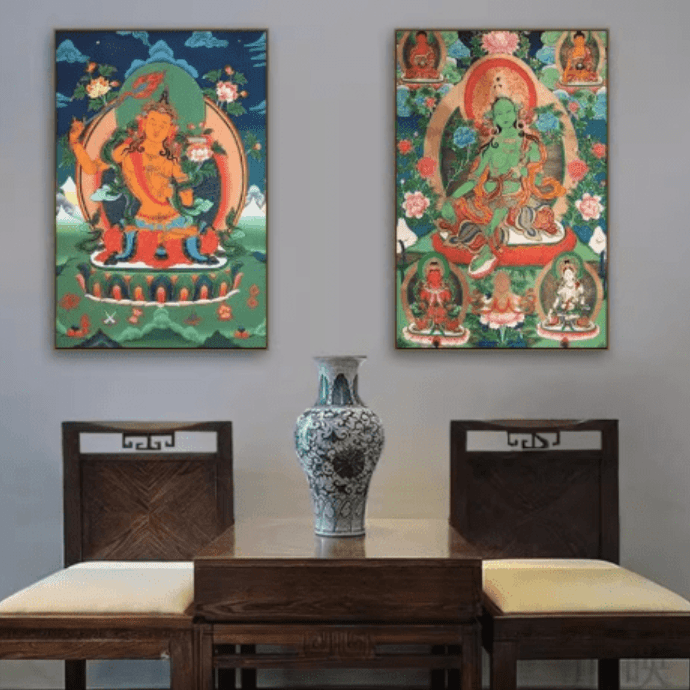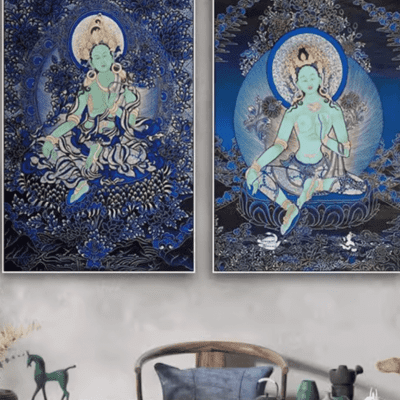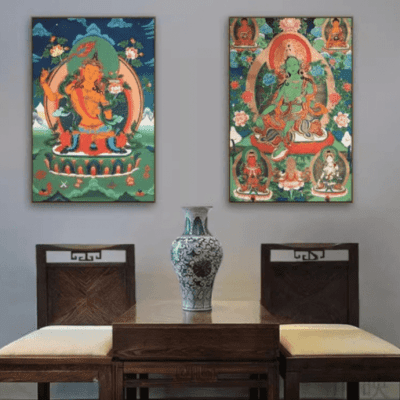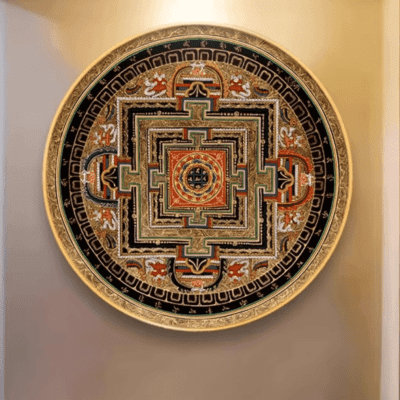Tibetan Thangka Explained: Mysticism, Healing, and Symbolism

In the 13th century, high on the moonlit plateau of Amdo, a nomad named Dorje stumbled upon a tattered scroll half-buried in snow. It was a Thangka, its edges frayed but its gold leaf still shimmering like trapped starlight. That night, as a blizzard howled outside his tent, Dorje unrolled it—and gasped. The central figure, a serene Buddha, seemed to breathe, its eyes softening as if acknowledging his presence. By dawn, the storm had vanished, and where the Thangka lay, wild lotuses bloomed through the ice. Locals whispered it was no mere painting, but a living vessel—one that had chosen Dorje to carry its secrets.
Have you ever wondered about such sacred scrolls, where pigment and prayer intertwine to create something beyond art? A Tibetan Thangka is a portal, a healer, and a storyteller all at once. What ancient wisdom do its colors hold? How does it bridge the gap between the seen and the unseen?
For over a millennium, Thangkas have guarded monasteries against dark forces, guided yogis through meditation, and appeared in dreams to those in need. From Himalayan caves to modern spiritual sanctuaries, they hum with a quiet power—one that transcends time and culture. Whether you seek healing, clarity, or a deeper connection to the divine, unlocking the Thangka’s mysteries will reveal paths to inner peace you never knew existed.
This passage will explore:
- What is a Tibetan Thangka?
- Ancient Origins and Mystical Legends
- Sacred Materials and Their Alchemy
- The Language of Symbols: Colors and Figures
- How to Engage with a Thangka: Meditation and Reverence
- Symbolism in Every Brushstroke
- Types of Thangkas: From Mandalas to Deities
- Caring for Your Thangka: Preservation and Blessing
- Modern Healing: Thangkas in Contemporary Life
- Conclusion
- FAQs
1. What is a Tibetan Thangka?
A Tibetan Thangka is a sacred scroll painting, typically created on cotton or silk, depicting deities, Buddhas, historical masters, cosmic mandalas, or spiritual narratives. The word “Thangka” derives from the Tibetan thang yig, meaning “recorded message”—for these paintings are not mere art, but visual teachings, encoding the entire spectrum of Buddhist philosophy in color and form.
Traditional Structure and Purpose
A Thangka’s structure is deliberate and sacred. It begins with a wooden frame (khang), symbolizing the stability of the Dharma. The painted surface is bordered by silk brocade (khyam), representing the protection of the spiritual path. At the top, a silk cord allows it to be rolled like a scroll—concealing its power when not in use, and unfurling it as a revelation during rituals.
2. Ancient Origins and Mystical Legends
The origins of Thangka trace back to the 7th century, when Princess Wencheng of China brought Buddhist art to Tibet. But legend weaves a more mystical tale: it is said that Guru Rinpoche (Padmasambhava), the founder of Tibetan Buddhism, once painted a Thangka in mid-air using only light, to awaken a stubborn king from ignorance. The painting floated until the king’s heart softened—proof that Thangkas hold power beyond the material.
The Hidden Hand of Divine Inspiration
Tibetan masters believe true Thangkas are not “created” but “channeled.” A 15th-century account tells of a hermit painter who fasted for 49 days, begging for guidance. On the final night, the Bodhisattva Avalokiteshvara appeared in a dream, holding a lotus that bloomed to reveal a Thangka. The painter copied it exactly, and the finished work was said to emit a soft glow—healing all who gazed upon it.
3. Sacred Materials and Their Alchemy
Thangkas are born from materials steeped in ritual. Pigments are ground from semi-precious stones: lapis lazuli for celestial blues (mined from Afghanistan’s mountains, where it is said to hold starlight), cinnabar for vibrant reds (blessed to transform poison into protection), and gold leaf beaten so thin it shimmers like liquid sunlight.
The Ritual of Preparation
Before mixing pigments, monks chant mantras to infuse them with intention. A single Thangka might require years of preparation: gold is purified with saffron water, stones are ground during full moons to align with lunar energy, and silk is dyed using plants harvested on auspicious days. This “alchemy” ensures the Thangka is not just a visual object, but a vessel of accumulated spiritual energy.

4. The Language of Symbols: Colors and Figures
Every element in a Thangka speaks a secret language. Gold symbolizes enlightenment—the pure essence beyond form. Red represents compassion, burning away attachment like fire. Green, the color of 松石,signifies healing and growth, mirroring the lush valleys of Tibet.
Divine Figures as Guides
A Thangka’s central figure reveals its purpose. Avalokiteshvara (Chenrezig), with a thousand arms, teaches boundless compassion. Manjushri, wielding a sword, cuts through ignorance with wisdom. Even the posture matters: a Buddha with hands in dhyana mudra (meditation gesture) invites calm, while one in abhaya mudra (fearlessness) offers protection.
5. How to Engage with a Thangka: Meditation and Reverence
To work with a Thangka is to enter a dialogue with the divine. Begin by sitting quietly before it, hands folded in respect. Let your gaze soften, resting not on details, but on the overall energy. Breathe deeply, and visualize the figure’s qualities (compassion, wisdom) flowing into you.
Rituals of Respect
Never hang a Thangka below waist level, nor place it near clutter or negativity. Some practitioners offer a single white flower or a pinch of saffron as a gesture of gratitude. When rolling it up, do so slowly—like tucking a sacred secret away, to be honored again.
6. Symbolism in Every Brushstroke
A Thangka’s lines are not random. Curved strokes represent fluidity and emptiness, while straight lines denote discipline. Even “imperfections” hold meaning: a slightly uneven lotus petal reminds us that beauty lies in impermanence.
The Mandala: A Microcosm of the Universe
Mandalas—circular Thangkas of geometric precision—map the cosmos. Their concentric circles move from chaos (outer edges) to order (central deity), mirroring the journey from ignorance to enlightenment. Meditating on a mandala is said to align one’s energy with the universe’s rhythm.
7. Types of Thangkas: From Mandalas to Deities
- Deity Thangkas: Focus on a single divine figure, aiding devotion.
- Mandala Thangkas: Used for visualization practices, guiding meditators to cosmic unity.
- Biographical Thangkas: Depict the life of Buddha or masters, teaching through story.
- Astrological Thangkas: Blend astronomy and spirituality, used for divination and healing.
8. Caring for Your Thangka: Preservation and Blessing
A Thangka is alive with energy, requiring care to stay vibrant. Keep it away from direct sunlight (to protect pigments) and dampness (to prevent mold). Once a year, invite a lama to bless it—chanting mantras to refresh its spiritual power.
Restoration as Rebirth
If a Thangka frays or fades, restoration is a sacred act. A master restorer will meditate before working, using the same traditional materials. It is said that each repair infuses the Thangka with new life, as if it absorbs the devotion of every generation that cares for it.
9. Modern Healing: Thangkas in Contemporary Life
In a world of digital noise, Thangkas offer a sanctuary of stillness. Many use them in meditation rooms, letting their colors calm overstimulated minds. Psychologists note that gazing at a Thangka’s balanced composition can reduce anxiety, as the eyes follow its harmonious patterns—grounding us in the present.
Bridging Ancient and Modern
Today, Thangkas inspire not just spiritual seekers, but artists and designers drawn to their timeless beauty. Yet their core purpose remains: to remind us that the sacred is not distant, but alive—in every brushstroke, every color, every silent moment of reflection.
10. Conclusion
A Tibetan Thangka is more than art—it is a living tradition, a healing presence, and a mirror reflecting our own potential for enlightenment. In its gold leaf and gemstone pigments, in its divine figures and cosmic patterns, we find a map for the soul: guiding us toward compassion, wisdom, and peace.

11. FAQs
Q: Can anyone own a Thangka?
A: Yes, but with respect. Approach it as a spiritual tool, not mere decoration.
A: Yes, but with respect. Approach it as a spiritual tool, not mere decoration.
Q: How do I choose the right Thangka?
A: Let your intuition guide you. A Thangka that resonates will draw your gaze repeatedly, often reflecting qualities you wish to cultivate (e.g., compassion, courage).
A: Let your intuition guide you. A Thangka that resonates will draw your gaze repeatedly, often reflecting qualities you wish to cultivate (e.g., compassion, courage).
Q: Is it okay to photograph a Thangka?
A: In most cases, yes, but avoid using flash (it harms pigments). Always ask permission in monasteries—some Thangkas are too sacred to be captured.
A: In most cases, yes, but avoid using flash (it harms pigments). Always ask permission in monasteries—some Thangkas are too sacred to be captured.
Q: Do Thangkas have healing powers?
A: Many believe their energy promotes emotional balance and clarity. Their symbolism and beauty can certainly calm the mind—a form of healing in itself.
A: Many believe their energy promotes emotional balance and clarity. Their symbolism and beauty can certainly calm the mind—a form of healing in itself.
